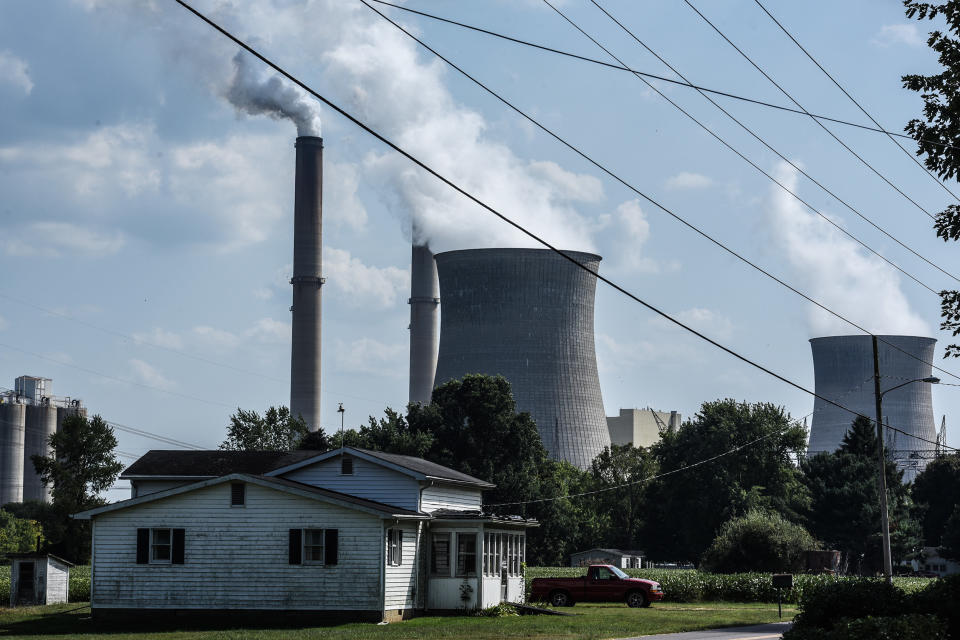Biden administration’s power plant rules underscore reality of EPA limits
The Biden administration’s proposed power plant regulations could dramatically reduce carbon emissions while also allowing some fossil fuel infrastructure to continue operating without an end date in sight.
That dichotomy — a result of the administration’s complicated bet on carbon capture and hydrogen technologies — could leave some communities to continue reckoning with air pollution and other localized impacts from some coal and natural gas power plants, even as the nation gets nearer to its climate goals.
As many national environmental organizations like the Sierra Club touted the rulemaking’s potential to reduce emissions, some local environmental justice leaders expressed mostly concern about what it could mean for their communities.
“It’s extending the life of fossil gas plants and will increase air pollution in disadvantaged communities,” said Juan Jhong Chung, a policy director of the Michigan Environmental Justice Coalition. “Those policies will lead to sacrifice zones. A lot of the burdens are localized and the benefits go to whiter wealthier communities.”
The rulemaking, which the Environmental Protection Agency announced Thursday, could broaden fault lines within the environmental community as the administration tries to stay between lines drawn by the Supreme Court and still achieve its climate ambitions.
The draft of the regulations will now undergo a monthslong public process before it is finalized. Once implemented, the regulations will almost certainly face legal challenges from industry groups and states led by Republican attorneys general.

The proposed rules would require nearly all of the United States’ coal and large gas plants to reduce or capture about 90% of their carbon dioxide emissions by 2038.
The EPA designed the rule to conform to the Supreme Court’s June decision in the West Virginia v. EPA case. The court said the EPA could not use provisions of the Clean Air Act to make utilities shift away from coal-fired power plants and move to generating power with wind, solar and other cleaner sources of energy.
But it left other options intact within the law, including requiring pollution limits like the ones the EPA proposed Thursday, which would force gas and coal plants to capture and store carbon pollution. Gas plants could also co-fire with hydrogen, meaning they would use a cleaner fuel for at least part of their generation.
Environmental attorneys said the EPA tailored its new regulations to fit within the Supreme Court’s ruling.
“What you can do is the traditional approach: to set pollution standards that reflect numerical emission limits that can be achieved by affecting pollution controls on individual plants,” said David Doniger, an attorney and senior strategic director of the climate and clean energy program at the Natural Resources Defense Council, which supports the rulemaking.
If the rules are enacted, some power companies might choose to retrofit their plants with carbon capture and storage technology, which has not been implemented or proven to be effective at a broad scale. Others might choose to retire coal and gas plants and invest in renewables like wind and solar, a trend already happening as these technologies decrease in cost.
“It will be up to companies to decide which plants they’ll operate for a long time and at a high rate,” Doniger said. “This rule is intended to sort of backstop the business as usual, make sure it happens and go further and faster.”
The Inflation Reduction Act included subsidies that apply to carbon capture and storage technology and hydrogen technologies, which could make those technologies cheaper and help bolster the EPA’s case that it’s not overly burdensome for companies to regulate their emissions.
Doniger said he thought the rulemaking would hold up to court scrutiny.
The rulemaking doesn’t cover all power plants equally. Some smaller power plants and those used only when demand is extremely high — called peaking units — wouldn’t be subject to the same stringent standards. That’s been of concern to some environmental advocates.
“Those peaker plants are the ones closest to environmental justice communities, Black and brown communities, communities of color,” Jhong Chung said, adding that carbon capture and hydrogen were unproven solutions. “We will see more cases of respiratory illnesses here” in Detroit.
Some small gas plants could actually run more often as companies shift how they supply energy to conform to the rulemaking if it’s enacted, Doniger said. That could produce more local air pollution from nitrogen oxides — or NOx — from small gas plants.
Doniger said the NRDC was eager to work with communities to find solutions and said the EPA would need to pay close attention to those kinds of pollution impacts.
“There are things EPA can do to strengthen pollution controls on categories of sources if we’ll have extra emissions of NOx on small gas plants because they run more,” Doniger said.
Environmental advocacy groups that are proponents of the rule, like the NRDC, think the rulemaking will ultimately shift power companies away from coal and natural gas, while giving those businesses choices during the transition.
But some environmental advocates say the Biden administration is falling short and giving an unnecessary lifeline to the fossil fuel industry.
“The rule continues to provide a pathway for fossil fuel plants to operate indefinitely at a time when we need to transition dramatically from fossil fuel plants to renewable energy plants,” said Jason Rylander, a senior attorney at the Center for Biological Diversity, who would prefer the administration pursue a nationwide cap on carbon emissions through a separate legal mechanism within the Clean Air Act.
This article was originally published on NBCNews.com

